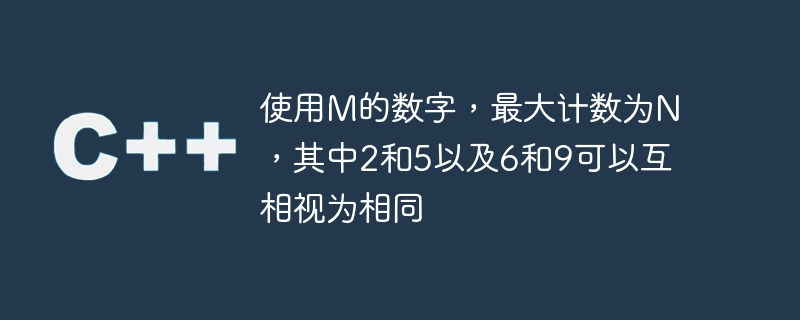使用M的数字,最大计数为N,其中2和5以及6和9可以互相视为相同
- PHPz转载
- 2023-09-05 16:09:031093浏览

Max count是一个可能的最大计数。在这里,我们给出了一个整数N和一个整数M的字符串。我们的任务是使用整数M的数字来组成数字N,并返回最大计数。同时,我们可以将2和5视为同一个数字,将6和9视为同一个数字。
样例示例
输入 1
N = 29 M = "2569783" Output 1: 2
解释 − 因为5和2相同,6和9相同,所以我们有两个'2'和两个'9'。因此,使用字符串M(2596783)的数字来组成数字N(29)的最大计数是2。
输入2
N = 999 M = 6666925 Output 2: 1
方法
让我们逐步讨论下面的方法-
首先,我们将创建一个名为‘maxCountOfN’的函数,该函数将以给定的字符串‘M’和数字‘N’作为参数,并将返回所需的整数‘maxCount’作为返回值。
在该函数中,我们将创建一个哈希映射 'mp' 来存储字符串 'M' 中每个数字的频率。
我们定义一个变量‘len’来存储字符串‘M’的大小。
从索引‘i = 0’开始遍历字符串‘M’,直到小于等于‘len’,并在此循环下执行以下操作:
如果我们得到的数字是‘2’,我们将其转换为‘5’。
如果我们得到一个数字为‘6’,我们将其转换为‘9’。
统计'mp'映射中每个数字的频率作为字符-整数对。
创建另一个哈希映射 'mpN' 以存储数字 N 的频率
使用while循环遍历数字‘N’,直到N大于0,并在此循环下执行以下操作 -
创建一个整数‘rem’来存储数字的最后一个元素
检查是否为2并将其转换为5
检查 rem 是否为 6 并将其转换为 9
将'mpN'映射中每个数字的频率计数为字符-整数对。即将整数作为字符存储在映射中,如'mpN[rem + '0']'。
将 N 减少到 N%10,以去除数字的最后一位
我们创建一个变量 'maxCount',其中存储 'INT_MAX'。
最后,我们遍历地图 'mpN' 来找到 N 的最大计数,并在此循环下执行以下操作 -
在变量‘key’中存储数字的位数
检查键是否存在于字符串的映射中,如果不存在意味着我们无法使用字符串'M'的数字创建数字'N',我们返回'0'。
在变量'tempCount'中创建一个变量,我们将值存储在其中(将字符串M中的数字频率除以N的当前数字频率)。
在maxCount中,我们存储tempCount和maxCount的最小值,因为只有当数字'N'的每个数字都出现在字符串'M'中时,才可能生成数字'N'
Return maxCount
Example
的中文翻译为:示例
#include <bits/stdc++.h>
using namespace std;
int maxCountOfN(int N, string M){
map< char, int >mp; //created hashmap to store the frequency of each digit of //string
int len = M.size(); // getting the size of the string
// iterating string using for loop
for(int i=0;i<len;i++){
if(M[i] == '2'){
M[i] = '5'; // replace 2 with 5
}
else if(M[i] == '6'){
M[i] = '9'; // replace 6 with 9
}
mp[M[i]]++; //count frequency of digit of string
}
// creating another hashmap to store the frequency of digit of the number N
map<char, int>mpN;
// iterating number 'N' using while loop
while(N > 0){
int rem = N % 10; // Get the last digit as the remainder
//Replace 2 with 5
if(rem == 2){
rem = 5;
}
//Replace 6 with 9
if(rem == 6){
rem = 9;
}
mpN[rem + '0']++; //count frequency of digit of number
N = N / 10;
}
int maxCount = INT_MAX;
//Trvaerse the hashmap of the number to get the maxCount
for(auto el : mpN){
// Get the key which is a digit from the number N to be formed
int key = el.first;
// If the key is not present in the string M, then the number N cannot be formed
if (!mp.count(key))
return 0;
// Divide the frequency of the digit from the string M with the frequency of the current digit of N
int tempCount = mp[key] / el.second;
// Choose the minimum
maxCount = min(maxCount, tempCount);
}
// returning the maximum count
return maxCount;
}
// main function
int main(){
int N = 29; // given number
string M = "2569783";// given string
// calling the function to get a maximum count of N
int maxCount = maxCountOfN(N, M);
cout<<"The max count of making the number "<< N << " using the digits of the string " << M << " is "<< maxCount<<endl;
return 0;
}
输出
The max count of making the number 29 using the digits of the string 2569783 is 2
结论
In this tutorial, we have implemented a program to find the Max count of N using digits of M such that 2 and 5, and, 6 and 9 can be treated as the same respectively. We have implemented an approach of hashing as we have to store the frequency with the time complexity of O(N+M) and space complexity of O(N+M). Where M is the size of the string and N is the size of the Number.
以上是使用M的数字,最大计数为N,其中2和5以及6和9可以互相视为相同的详细内容。更多信息请关注PHP中文网其他相关文章!

